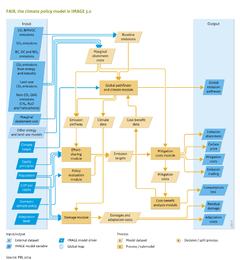Climate policy/Description: Difference between revisions
Jump to navigation
Jump to search
No edit summary |
No edit summary |
||
| Line 16: | Line 16: | ||
Input for the modules consists of baseline scenarios on population, GDP and emissions, as calculated by the IMAGE modelling framework. Emissions are from all major sources and include all six Kyoto greenhouse gases. Marginal abatement cost ([[HasAcronym::MAC]]) curves describing mitigation potential and costs of greenhouse gas emission reductions are derived from the TIMER energy model and the IMAGE land-use model. The MAC curves take into account a wide range of options, including carbon plantations, carbon capture and storage ([[HasAcronym::CCS]]), bio, wind and solar energy, and energy efficiency and technological improvements. In addition, FAIR can also use emission projections and MACs from other models, such as the [[POLES energy system model]] ([[Enerdata, 2010]]) and [[IIASA land-use models]] ([[Kindermann et al., 2008]]), to assess the sensitivity of the outcomes to these main inputs. | Input for the modules consists of baseline scenarios on population, GDP and emissions, as calculated by the IMAGE modelling framework. Emissions are from all major sources and include all six Kyoto greenhouse gases. Marginal abatement cost ([[HasAcronym::MAC]]) curves describing mitigation potential and costs of greenhouse gas emission reductions are derived from the TIMER energy model and the IMAGE land-use model. The MAC curves take into account a wide range of options, including carbon plantations, carbon capture and storage ([[HasAcronym::CCS]]), bio, wind and solar energy, and energy efficiency and technological improvements. In addition, FAIR can also use emission projections and MACs from other models, such as the [[POLES model|POLES energy system model]] ([[Enerdata, 2010]]) and [[**IIASA land-use models]] ([[Kindermann et al., 2008]]), to assess the sensitivity of the outcomes to these main inputs. | ||
The modules are described in more detail below. | The modules are described in more detail below. | ||
| Line 22: | Line 22: | ||
===Global pathfinder and climate module=== | ===Global pathfinder and climate module=== | ||
The pathfinder module [[FAIR-SiMCaP]] calculates global emission pathways that satisfy a long-term climate target ([[Den Elzen et al., 2007]]; [[Van Vliet et al., 2009]]; [[Van Vuuren et al., 2011]]) . Input are climate targets that are defined in terms of concentration levels, radiative forcing, temperature, or cumulative emissions. Intermediate restrictions on overshoot levels or intermediate emission targets representing climate policy progress also can be included. The model combines the mitigation costs model of FAIR and a module that minimises cumulative discounted mitigation costs by varying the timing of emission reductions. For the climate calculations, FAIR-SiMCaP uses the [[MAGICC]] 6 model, with parameter settings calibrated to reproduce the medium response in terms of time scale and amplitude of 19 IPCC AR4 General Circulation Models ([[Meinshausen et al., 2011c]]). | The pathfinder module [[FAIR-SiMCaP model|FAIR-SiMCaP*]] calculates global emission pathways that satisfy a long-term climate target ([[Den Elzen et al., 2007]]; [[Van Vliet et al., 2009]]; [[Van Vuuren et al., 2011]]) . Input are climate targets that are defined in terms of concentration levels, radiative forcing, temperature, or cumulative emissions. Intermediate restrictions on overshoot levels or intermediate emission targets representing climate policy progress also can be included. The model combines the mitigation costs model of FAIR and a module that minimises cumulative discounted mitigation costs by varying the timing of emission reductions. For the climate calculations, FAIR-SiMCaP uses the [[MAGICC model|MAGICC]] 6 model, with parameter settings calibrated to reproduce the medium response in terms of time scale and amplitude of 19 [[IPCC]] [[AR|AR4]] General Circulation Models ([[Meinshausen et al., 2011c]]). | ||
===Policy evaluation module=== | ===Policy evaluation module=== | ||
Revision as of 13:37, 17 December 2013
Parts of Climate policy/Description
| Component is implemented in: |
|
| Related IMAGE components |
| Models/Databases |
| Key publications |
| References |
|
